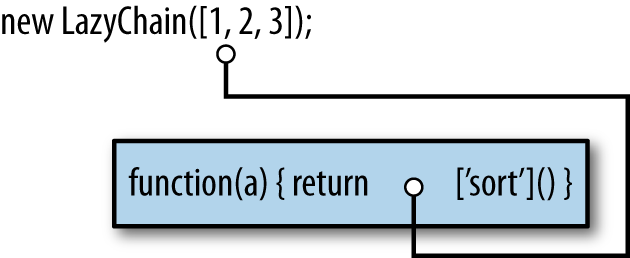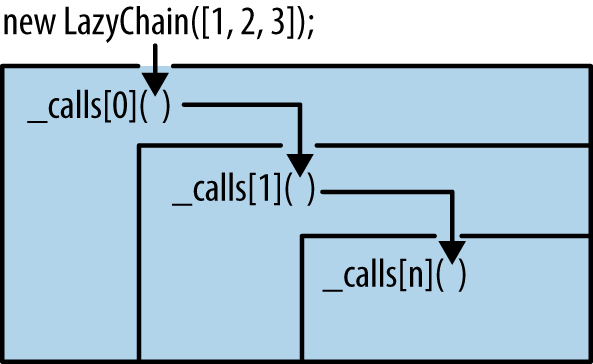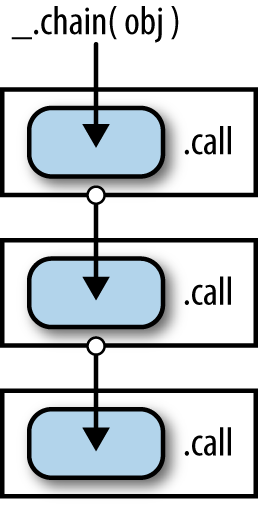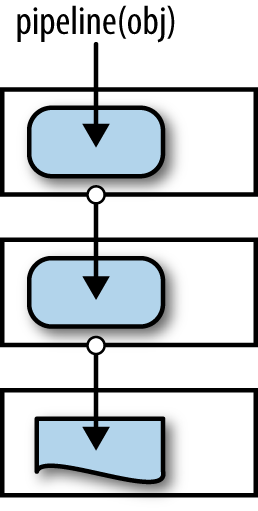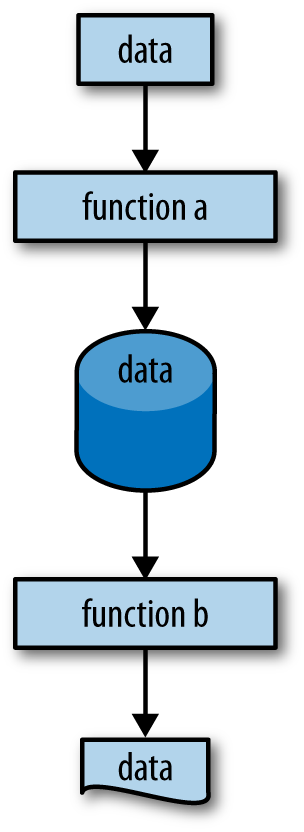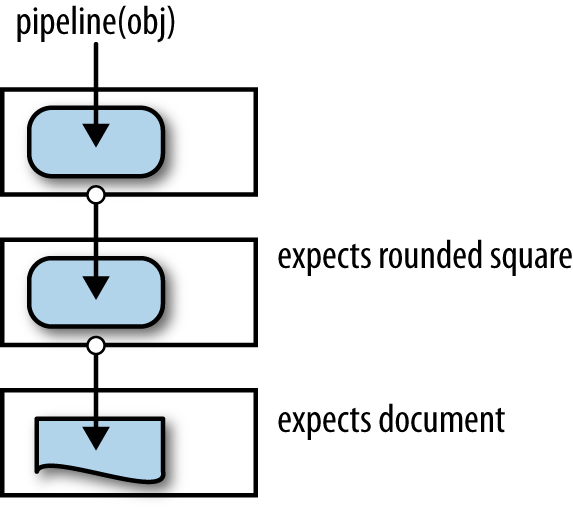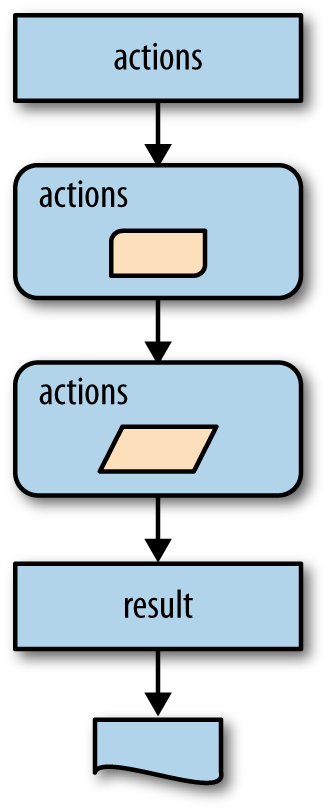This chapter continues the discussion of functional style by showing how functions, together with purity and isolated change, can compose to offer a fairly fluent programming style. The idea of snapping functional blocks together will be discussed herein and demonstrated with relevant examples.
If you recall, in the implementation of condition1 from Chapter 5, I
resorted to using the following lines of code:
// ...varerrors=mapcat(function(isValid){returnisValid(arg)?[]:[isValid.message];},validators);// ...
The reason for this bit of trickery was that while the final result needed to be an array of error strings, each intermediate step could be either an array of suberror messages or nothing at all. Another reason was that I wanted to combine disparate behaviors, each with different return types. It would be much easier to compose these behaviors if the return value of one was of a form agreeable to the input arguments to the other. Take, for example, the following code:
functioncreatePerson(){varfirstName="";varlastName="";varage=0;return{setFirstName:function(fn){firstName=fn;returnthis;},setLastName:function(ln){lastName=ln;returnthis;},setAge:function(a){age=a;returnthis;},toString:function(){return[firstName,lastName,age].join(' ');}};}createPerson().setFirstName("Mike").setLastName("Fogus").setAge(108).toString();//=> "Mike Fogus 108"
The “magic” that allows method chains is that each method in the
chain returns the same host object reference (Stefanov 2010). The chaining
of methods via common return value is effectively a design pattern in
JavaScript finding its way into jQuery and even Underscore. In fact, three
useful functions in Underscore are _.tap, _.chain, and _.value. If you recall from Chapter 2, I used these functions to implement the lyricSegment function used to build a “99
bottles” song generator. However, in that implementation I glossed over
just how these functions operate.
The _.chain function is the most
hardcore of the three, allowing you to specify an object as an implicit
target to repeated Underscore functions pretending to be methods. A simple
example works best to start understanding _.chain:
_.chain(library).pluck('title').sort();//=> _
Um. What?[89]
Thankfully, there is a good explanation for why the Underscore
object was returned. You see, the _.chain function takes some object and wraps it
in another object that contains modified versions of all of Underscore’s
functions. That is, where a function like _.pluck has a call signature like function pluck(array, propertyName) by default, the modified version found in the
wrapper object used by _.chain looks
like function pluck(propertyName).
Underscore uses a lot of interesting trickery to allow this to happen, but
the result is that what passes from one wrapper method call to the next is
the wrapper object and not the target object itself.
Therefore, whenever you want to end the call to _.chain and extract the final value, the
_.value function is used:
_.chain(library).pluck('title').sort().value();//=> ["Joy of Clojure", "SICP", "SICP"]
With the use of _.result, you
take a value from the world of the wrapper object and bring it into the
“real world.” This notion will pop up again a couple of sections from now.
When using the _.chain function, you
might receive results for any number of buggy reasons. Imagine the
following scenario:
varTITLE_KEY='titel';// ... a whole bunch of code later_.chain(library).pluck(TITLE_KEY).sort().value();//=> [undefined, undefined, undefined]
Because the code is compact, the problem is obvious—I misspelled
“title.” However, in a large codebase you’re likely to start debugging
closer to the point of failure. Unfortunately, with the presence of the
_.chain call, there is seemingly no
easy way to tap into the chain
to inspect intermediate values. Not so. In fact, Underscore provides a
_.tap function that, given an object
and a function, calls the function with the object and returns the
object:
_.tap([1,2,3],note);;;NOTE:1,2,3//=> [1, 2, 3]
Passing the note
function[90] to Underscore’s tap shows
that indeed the function is called and the array returned. As you might
suspect, _.tap is also available in the
wrapper object used by _.chain, and
therefore can be used to inspect intermediate values, like so:
_.chain(library).tap(function(o){console.log(o)}).pluck(TITLE_KEY).sort().value();// [{title: "SICP" ...//=> [undefined, undefined, undefined]
Nothing seems amiss in the form of the library table, but what about if I move the tap
to a different location:
_.chain(library).pluck(TITLE_KEY).tap(note).sort().value();// NOTE: ,,//=> [undefined, undefined, undefined]
Now wait a minute; the result of the pluck is an odd looking array.
At this point, the tap has pointed to the location of the problem: the
call to _.pluck. Either there is a
problem with TITLE_KEY or a problem
with _.pluck itself. Thankfully, the
problem lies in the code under my control.
The use of _.chain is very
powerful, especially when you want to fluently describe a sequence of
actions occurring on a single target. However, there is one limitation of
_chain—it’s not lazy. What I mean by
what is hinted at in the following code:
_.chain(library).pluck('title').tap(note).sort();// NOTE: SICP,SICP,Joy of Clojure//=> _
Even though I never explicitly asked for the wrapped value with the
_.value function, all of the calls in
the chain were executed anyway. If _.chain were lazy, then none of the calls would
have occurred until the call to _.value.
Taking a lesson from the implementation of trampoline from Chapter 6, I can
implement a lazy variant of _.chain
that will not run any target methods until a variant of _.value is called:
functionLazyChain(obj){this._calls=[];this._target=obj;}
The constructor for the LazyChain object is simple enough; it takes a
target object like _.chain and sets
up an empty call array. While the operation of trampoline from Chapter 6
operated on an implicit chain of calls, LazyChain works with an explicit array
of…something. However, the question remains as to what it is that I put
into the _calls array. The most
logical choice is, of course, functions, as shown below:
LazyChain.prototype.invoke=function(methodName/*, args */){varargs=_.rest(arguments);this._calls.push(function(target){varmeth=target[methodName];returnmeth.apply(target,args);});returnthis;};
The LazyChain#invoke method is
fairly straightforward, but I could stand to walk through it. The
arguments to LazyChain#invoke are a
method name in the form of a string, and any additional arguments to the
method. What LazyChain#invoke does is
to “wrap” up the actual method call in a closure and push it onto the
_calls array. Observe what the
_calls array looks like after a
single invocation of LazyChain#invoke
here:
newLazyChain([2,1,3]).invoke('sort')._calls;//=> [function (target) { ... }]
As shown, the only element in the _calls array after adding one link to the lazy
chain is a single function that corresponds to a deferred
Array#sort method call on the array [2,1,3].
A function that wraps some behavior for later execution is
typically called a thunk[91] (see Figure 8-1). The thunk that’s stored
in _calls expects some intermediate
target that will serve as the object receiving the eventual method
call.
While thunks are not always functions in every programming language that supports them, in JavaScript it makes sense to implement them as such because functions are readily available.
Since the thunk is waiting to be called, why don’t I just call it to see what happens:
newLazyChain([2,1,3]).invoke('sort')._calls[0]();// TypeError: Cannot read property 'sort' of undefined
Well, that was less than satisfying. The problem is that directly
calling the thunk is not enough to make it execute properly. If you’ll
recall, the thunk expected a target
object to execute its closed-over method on. To make it work, I would
need to somehow pass the original array as an argument to the thunk, as
shown in Figure 8-2.
Figure 8-2. To make the LazyChain work, I have to find a way to loop the original object back into the call
I could satisfy the argument lookback manually by pasting the array into the thunk call as in the following:
newLazyChain([2,1,3]).invoke('sort')._calls[0]([2,1,3]);//=> [1, 2, 3]
Placing the argument directly into the thunk call seems not only
like cheating, but also like a terrible API. Instead, I can use the
_.reduce function to provide the
loopback argument not only to the initial thunk, but also every
intermediate call on the _calls
array:
LazyChain.prototype.force=function(){return_.reduce(this._calls,function(target,thunk){returnthunk(target);},this._target);};
The LazyChain#force function is
the execution engine for the lazy chaining logic. As shown in Figure 8-3, the use of _.reduce nicely provides the same kind of
trampolining logic as demonstrated in Chapter 6. Starting
with the initial target object, the thunk calls are called, one by one,
with the result of the previous call.
Now that LazyChain#force is in
place, observe what happens when it is used to “terminate” a lazy
chain:
newLazyChain([2,1,3]).invoke('sort').force();//=> [1, 2, 3]
Excellent! The logic seems sound, but what happens when more links are added to the chain? Observe:
newLazyChain([2,1,3]).invoke('concat',[8,5,7,6]).invoke('sort').invoke('join',' ').force();//=> "1 2 3 5 6 7 8"
I can chain as long as I want while remaining mindful of the way
that the types change from one link to the next. I mentioned earlier
that LazyChain was lazy in its
execution. While you might see how that is indeed the case because
thunks are stored in the _calls array
and never executed until LazyChain#force, it’s still better to show it
actually being lazy. First, let me implement a lazy version of _.tap that works with LazyChain instances:
LazyChain.prototype.tap=function(fun){this._calls.push(function(target){fun(target);returntarget;});returnthis;}
The operation of LazyChain#tap
is similar to LazyChain#invoke
because the actual work (i.e., calling a function and returning the
target) is wrapped in a thunk. I show how tap works below:
newLazyChain([2,1,3]).invoke('sort').tap(alert).force();// alert box pops up//=> "1,2,3"
But what happens if I never call LazyChain#force?
vardeferredSort=newLazyChain([2,1,3]).invoke('sort').tap(alert);deferredSort;//=> LazyChain
Nothing happens! I can hold onto deferredSort as long as I want and it’ll never
execute until I explicitly invoke it:
// ... in the not too distant futuredeferredSort.force();// alert box pops up//=> [1, 2, 3]
This operation is very similar to the way that something like
jQuery promises work. Before I talk a little bit about promises,
however, I want to explore an easy extension to LazyChain that allows me to, well, chain lazy
chains to other lazy chains. That is, keeping in mind that at the heart
of a LazyChain is just an array of
thunks, I can change the constructor to concatenate the arrays when
presented with another LazyChain as
its argument:
functionLazyChainChainChain(obj){varisLC=(objinstanceofLazyChain);this._calls=isLC?cat(obj._calls,[]):[];this._target=isLC?obj._target:obj;}LazyChainChainChain.prototype=LazyChain.prototype;
That is, if the argument to the constructor is another LazyChain instance, then just steal its call
chain and target object. Observe the chaining of chains:
newLazyChainChainChain(deferredSort).invoke('toString').force();// an alert box pops up//=> "1,2,3"
Allowing chains to compose in this way is a very powerful idea. It
allows you to build up a library of discrete behaviors without worrying
about the final result. There are other ways to enhance LazyChain, such as caching the result and
providing an interface that does not rely on strings, but I leave that
as an exercise for the reader.
While LazyChain and LazyChainChainChain are useful for packaging
the description of a computation for later execution, jQuery[92] provides something called a promise
that works similarly, but slightly differently. That is, jQuery promises
are intended to provide a fluent API for sequencing asynchronous
operations that run concurrent to the main program logic.
First, the simplest way to look at a promise is that it represents
an unfulfilled activity. As shown in the following code, jQuery allows
the creation of promises via $.Deferred:
varlonging=$.Deferred();
I can now grab a promise from the Deferred:
longing.promise();//=> Object
The object returned is the handle to the unfulfilled action:
longing.promise().state();//=> "pending"
As shown, the promise is in a holding pattern. The reason for this is of course that the promise was never fulfilled. I can do so simply by resolving it:
longing.resolve("<3");longing.promise().state();//=> "resolved"
At this point, the promise has been fulfilled and the value is accessible:
longing.promise().done(note);// NOTE: <3//=> <the promise itself>
The Deferred#done method is
just one of many useful chaining methods available in the promise API. I
will not go into depth about jQuery promises, but a more complicated
example could help to show how they differ from lazy chains. One way to
build a promise in jQuery is to use the $.when function to start a promise chain, as
shown here:
functiongo(){vard=$.Deferred();$.when("").then(function(){setTimeout(function(){console.log("sub-task 1");},5000)}).then(function(){setTimeout(function(){console.log("sub-task 2");},10000)}).then(function(){setTimeout(function(){d.resolve("done done done done");},15000)})returnd.promise();}
The promise chain built in the go function is very simple-minded. That is,
all I’ve done is to tell jQuery to kick off three asynchronous tasks,
each delayed by increasingly longer timings. The Deferred#then methods each take a function and
execute them immediately. Only in the longest-running task is the
Deferred instance resolved. Running
go illustrates this example:
varyearning=go().done(note);
I tacked on a done call to the
promise that will get called whenever the promise is resolved. However,
immediately after running go, nothing
appears to have happened. That’s because due to the timeouts in the
subtasks, the console logging has not yet occurred. I can check the
promise state using the aptly named state method:
yearning.state();//=> "pending"
As you might expect, the state is still pending. After a few seconds, however:
// (console) sub-task 1The timeout of the first subtask triggers and a notification is printed to the console.
yearning.state();//=> "pending"
Of course, because the other two actions in the original promise chain are awaiting timeouts, the state is still pending. However, again waiting for some number of seconds to pass shows the following:
// (console) sub-task 2// ... ~5 seconds later// NOTE: done done done done
Eventually, the final link in the deferred chain is called, and
the done notification is printed by the note function. Checking the state one more
time reveals the following:
yearning.state();//=> "resolved"
Of course, the promise has been resolved because the final subtask
ran and called resolve on the
original Deferred instance. This
sequence of events is very different from that presented using LazyChain. That is, a LazyChain represents a strict sequence of
calls that calculate a value. Promises, on the other hand, also
represent a sequence of calls, but differ in that once they are
executed, the value is available on demand.
Further, jQuery’s promise API is meant to define aggregate tasks
composed of some number of asynchronous subtasks. The subtasks
themselves execute, as possible, concurrently. However, the aggregate
task is not considered completed until every subtask has finished
and a value is delivered to the promise via the
resolve method.
A lazy chain also represents an aggregate task composed of
subtasks, but they, once forced, are always run one after the other. The
difference between the two can be summarized as the difference between
aggregating highly connected tasks (LazyChain) versus loosely related (Deferred) tasks.
Most of jQuery’s asynchronous API calls now return promises, so the result of an async call is chainable according to the promise API. However, the complete specification of this API is outside the scope of this book.
Chaining is a useful pattern for creating fluent APIs built around
objects and method calls, but is less useful for functional APIs. The
Underscore library is built for chaining via _.chain, as most functions take a collection as
the first argument. By contrast, the functions in this book take functions
as their first argument. This choice was explicit, to foster partial
application and currying.
There are various downsides to method chaining including tight-coupling of object set and get logic (which Fowler refers to as command/query separation [2010]) and awkward naming problems. However, the primary problem is that very often method chains mutate some common reference from one call to the rest, as shown in Figure 8-4. Functional APIs, on the other hand, work with values rather than references and often subtly (and sometimes not so subtly) transform the data, returning the new result.
In this section, I’ll talk about function pipelines and how to use them to great effect. In an ideal world, the original data presented to a function should remain the same after the call. The chain of calls in a functional code base are built from expected data values coming in, nondestructive transformations, and new data returned—strung end to end, as shown in Figure 8-5.
A “faux” API for such a pipeline of transformations can look like the following:
pipeline([2,3,null,1,42,false],_.compact,_.initial,_.rest,rev);//=> [1, 3]
The sequence of this pipeline call could be described as follows:
Take the array
[2, 3, null, 1, 42, false]and pass it to the_.compactfunction.Take the result of
_.compactand pass it to_.initial.Take the result of
_.initialand pass it to_.rest.Take the result of
_.restand pass it torev.
In other words, the pipeline looks like the following if written out as nested calls:
rev(_.rest(_.initial(_.compact([2,3,null,1,42,false]))));//=> [1, 3]
This description should start setting off alarms bells in you brain.
That’s because this description is almost the same as the description of
LazyChain#force. The same result/call
weaving is prevalent in both algorithms. Therefore, the implementation of
pipeline should look very similar to
LazyChain#force, and indeed it
is:
functionpipeline(seed/*, args */){return_.reduce(_.rest(arguments),function(l,r){returnr(l);},seed);};
The use of _.reduce makes
pipeline almost trivial, however, with
a seemingly small amount of code comes great power. Before I dig into this
power, look at a few examples of pipeline in action:
pipeline();//=> undefinedpipeline(42);//=> 42pipeline(42,function(n){return-n});//=> -42
The first argument to pipeline
serves as the seed value, or in other words, the value that starts as the
argument to the first function. The result of each subsequent function
call is then fed into the next function until all are exhausted.[93]
Pipelines are somewhat similar to lazy chains, except they are not
lazy and they work against values rather than mutable references.[94] Instead, pipelines are more akin to functions created using
_.compose. The act of making a pipeline
lazy is simply the act of encapsulating it within a function (or thunk if
you prefer):
functionfifth(a){returnpipeline(a,_.rest,_.rest,_.rest,_.rest,_.first);}
And now the act of forcing a pipeline is just to feed it a piece of data:
fifth([1,2,3,4,5]);//=> 5
A very powerful technique is to use the abstraction built via a pipeline and insert it into another pipeline. They compose thus:
functionnegativeFifth(a){returnpipeline(a,fifth,function(n){return-n});}negativeFifth([1,2,3,4,5,6,7,8,9]);//=> -5
This is interesting as an illustrative example, but it might be more
compelling to show how it could be used to create fluent APIs. Recall the
implementation of the relational algebra operators as, project,
and restrict from Chapter 2. Each function took as its first argument a table that
it used to generate a new table, “modified” in some way. These functions
seem perfect for use in a pipeline such as one to find all of the first
edition books in a table:
functionfirstEditions(table){returnpipeline(table,function(t){returnas(t,{ed:'edition'})},function(t){returnproject(t,['title','edition','isbn'])},function(t){returnrestrict(t,function(book){returnbook.edition===1;});});}
And here’s the use of firstEditions:
firstEditions(library);//=> [{title: "SICP", isbn: "0262010771", edition: 1},// {title: "Joy of Clojure", isbn: "1935182641", edition: 1}]
For processing and extracting elements from the table, the
relational operators worked well, but with pipeline, I
can make it nicer to deal with.
The problem is that the pipeline expects that the functions embedded
within take a single argument. Since the relational operators expect two,
an adapter function needs to wrap them in order to work within the
pipeline. However, the relational operators were designed very
specifically to conform to a consistent interface: the table is the first
argument and the “change” specification is the second. Taking advantage of
this consistency, I can use curry2 to
build curried versions of the relational operators to work toward a more
fluent experience:
varRQL={select:curry2(project),as:curry2(as),where:curry2(restrict)};
I’ve decided to namespace the curried functions inside of an object
RQL (standing for relational
query language) and change the names in two of the
circumstances to more closely mimic the SQL operators. Now that they are
curried, implementing an improved version of firstEditions reads more more cleanly:
functionallFirstEditions(table){returnpipeline(table,RQL.as({ed:'edition'}),RQL.select(['title','edition','isbn']),RQL.where(function(book){returnbook.edition===1;}));}
Aside from being easier to read,[95] the new allFirstEditions
function will work just as well:
allFirstEditions(table);//=> [{title: "SICP", isbn: "0262010771", edition: 1},// {title: "Joy of Clojure", isbn: "1935182641", edition: 1}]
The use of pipelines in JavaScript, coupled with currying and partial application, works to provide a powerful way to compose functions in a fluent manner. In fact, the functions created in this book were designed to work nicely in pipelines. As an added advantage, functional programming focuses on the transformation of data as it flows from one function to the next, but this fact can often be obscured by indirection and deep function nesting. Using a pipeline can work to make the data flow more explicit. However, pipelines are not appropriate in all cases. In fact, I would rarely use a pipeline to perform side-effectful acts like I/O, Ajax calls, or mutations because they very often return nothing of value.
The data going into a pipeline should be the same after the pipeline has completed. This helps ensure that the pipelines are composable. Is there a way that I can compose impure functions along a pipeline-like structure? In the next section, I’ll talk a bit about a way to perform side effects in a composable and fluent way, building on the lessons learned while exploring chains and pipelines.
In the lazyChain example, I
separated out the execution specification (via .invoke) from the execution logic (via .force). Likewise, with the pipeline function, I juxtaposed numerous pure
functions to achieve the equivalent of a serial processing pipeline. In
both the cases of lazyChain and
pipeline, the value moving from one
node in the call sequence to the next was stable. Specifically, lazyChain always returned some LazyChain-like object up until the point
force was called. Likewise, while at
any point in the pipeline the
intermediate type could change, the change was known prior to composition
to ensure the proper values were fed from one stage to the next. However,
what if we want to compose functions that were not necessarily meant to
compose?
In this final section of this chapter, I’ll talk about a technique
for composing functions of incongruous return types using a new kind of
lazy pipeline called actions (Stan
2011).
If you imagine a function as a box of indeterminate behavior taking as input data of some “shape” and outputting data of some other shape (possibly the same shape), then Figure 8-6 might be what you’d picture.[96]
Figure 8-6. Function a takes a rectangular shaped thing and returns a database shaped thing; function b takes a database shaped thing and returns a document shaped thing
Therefore, the reason that a lazy chain works properly is that the
shape from one chained method call to the next is consistent and only
changes[97] when force is called.
Figure 8-7 illustrates this fact.
Figure 8-7. The shape flowing between calls in a lazy chain is stable, only (potentially) changing when force is called
Similarly, the shape between the nodes of a pipeline or a composed function, while not as stable as a common object reference, is designed to change in accordance with the needs of the next node, as shown in Figure 8-8.
Figure 8-8. The shape flowing between calls in a pipeline or compose is designed to change in expected ways
The problem is that if the shapes do not align, then neither
pipeline, _.compose, nor lazyChain will operate as expected:
pipeline(42,sqr,note,function(n){return-n});// NOTE: 1764//=> NaN
Not cool. The reason that failed was because the shape of the type
changed in mid-stream to undefined
(from note).
In fact, if you want to achieve the correct effect, then you’d need to do so manually:
functionnegativeSqr(n){vars=sqr(n);note(n);return-s;}negativeSqr(42);// NOTE: 1764//=> -1764
While tenable, the amount of boilerplate involved in getting this to
work for larger capabilities grows quickly. Likewise, I could just change
the note function to return whatever
it’s given, and while that might be a good idea in general, doing so here
would solve only a symptom rather than the larger disease of incompatible
intermediate shapes. That there are functions that can return incompatible
shapes, or even no shape at all (i.e., no return) requires a delicate orchestration of
control flow to compose code. The requirements of this delicate balance
work against us in finding a way to compose functions that flow values
from one to the next.
By now you might think that the way to fix this problem is to somehow find a way to stabilize the shapes flowing between the nodes—that thinking is absolutely correct.
The complication in determining a common shape to flow between
nodes of a different sort is not picking a type (a regular object will
do), but what to put into it. One choice is the data that flows between
each node; in the negativeSqr
example, the object would look like the following:
{values:[42,1764,undefined,-1764]}
But what else is needed? I would say that a useful piece of data to keep around would be the state, or target object used as the common target between nodes. Figure 8-9 shows a way to visualize how actions could be composed, even in the face of disparate input and output shapes.
The last node (i.e., results) operates much in the same way as
force in that it pulls the answer out
of the action object into the real world. In the case of the negativeSqr function, the way to get the final
answer is to retrieve the last element of the values element or just return the
state:
{values:[42,1764,undefined,-1764],state:-1764}
Now, the implementation of the actions function to manage these intermediate
states is a hybrid of the pipeline
and lazyChain implementations, as
shown here:
functionactions(acts,done){returnfunction(seed){varinit={values:[],state:seed};varintermediate=_.reduce(acts,function(stateObj,action){varresult=action(stateObj.state);varvalues=cat(stateObj.values,[result.answer]);return{values:values,state:result.state};},init);varkeep=_.filter(intermediate.values,existy);returndone(keep,intermediate.state);};};
The actions function expects an
array of functions, each taking a value and returning a function that
augments the intermediate state object. The actions function then reduces over all of the
functions in the array and builds up an intermediate state object, as
shown here:
...varintermediate=_.reduce(acts,function(stateObj,action){varresult=action(stateObj.state);varvalues=cat(stateObj.values,[result.answer]);return{values:values,state:result.state};},init);...
During this process, actions
expects the result from each function to be an object of two keys:
answer and state. The answer value corresponds to the result of
calling the function and the state
value represents what the new state looks like after the “action” is
performed. For a function like note,
the state does not change. The intermediate state object might have some
bogus answers in it (e.g., the answer
of note is undefined), so actions filters those out:
...varkeep=_.filter(intermediate.values,existy);returndone(keep,intermediate.state);...
Finally, actions passes the
filtered values (called keep) and state into the done function to garner a final result. I
could have only passed the state or
values into the done function, but I like to pass both for
maximum flexibility, and because it helps for illustration.
To demonstrate how actions
works, I’ll need to break apart negativeSqr and recompose it as a series of
actions. First, the sqr function
obviously doesn’t know anything about a state object, so I’ll need to
create an adapter function, called mSqr:[98]
functionmSqr(){returnfunction(state){varans=sqr(state);return{answer:ans,state:ans};}}
I can now use actions just to
perform a double-squaring operation:
vardoubleSquareAction=actions([mSqr(),mSqr()],function(values){returnvalues;});doubleSquareAction(10);//=> [100, 10000]
Since I returned the values
array directly, the result of doubleSquareAction is all of the intermediate
states (specifically the square of 10 and the square of the square of
10). However, this is almost the same as pipeline. The real magic comes when mixing
functions of differing shapes:
functionmNote(){returnfunction(state){note(state);return{answer:undefined,state:state};}}
The answer of the mNote function is, of course, undefined, since it is a function used for
printing; however, the state is just
passed along. The mNeg function
should by now seem apparent:
functionmNeg(){returnfunction(state){return{answer:-state,state:-state};}}
And now composing these new functions into actions is shown here:
varnegativeSqrAction=actions([mSqr(),mNote(),mNeg()],function(_,state){returnstate;});
Its usage is shown here:
negativeSqrAction(9);// NOTE: 81//=> -81
Using the actions paradigm for
composition is a general way to compose functions of different shapes.
Sadly, the preceding code seems like a lot of ceremony to achieve the
effects needed. Fortunately, there is a better way to define an action,
without needing to know the details of how a state object is built and
avoiding the pile of boilerplate that goes along with that
knowledge.
In this section, I’ll define a function, lift, that takes two functions: a function to
provide the result of some action given a value, and another function to
provide what the new state looks like. The lift function will be used to abstract away
the management of the state object used as the intermediate
representation of actions. The
implementation of lift is quite
small:
functionlift(answerFun,stateFun){returnfunction(/* args */){varargs=_.toArray(arguments);returnfunction(state){varans=answerFun.apply(null,construct(state,args));vars=stateFun?stateFun(state):ans;return{answer:ans,state:s};};};};
lift looks like it’s curried
(i.e., it returns a function), and indeed it is. There is no reason to
curry lift except to provide a nicer interface, as
I’ll show in a moment. In fact, using lift, I can more nicely redefine mSqr, mNote, and mNeg:
varmSqr2=lift(sqr);varmNote2=lift(note,_.identity);varmNeg2=lift(function(n){return-n});
In the case of sqr and the
negation function, both the answer and the state are the same value, so
I only needed to supply the answer function. In the case of note, however, the answer (undefined) is clearly not the state value, so
using _.identity allows me to specify
that it’s a pass-through action.
The new actions compose via actions:
varnegativeSqrAction2=actions([mSqr2(),mNote2(),mNeg2()],function(_,state){returnstate;});
And their usage is the same as before:
negativeSqrAction(100);// NOTE: 10000//=> -10000
If I want to use lift and
actions to implement a stackAction,
then I could do so as follows:
varpush=lift(function(stack,e){returnconstruct(e,stack)});
The push function returns a new
array, masquerading as a stack, with the new element at the front. Since
the intermediate state is also the answer, there is no need to supply a
state function. The implementation of pop needs both:
varpop=lift(_.first,_.rest);
Since I’m simulating a stack via an array, the
pop answer is the first element. Conversely, the
state function _.rest return the new
stack with the top element removed. I can now use these two functions to
compose two pushes and one pop, as follows:
varstackAction=actions([push(1),push(2),pop()],function(values,state){returnvalues;});
Amazingly, by using the actions
function, I’ve captured the sequence of stack events as a value that has
not yet been realized. To realize the result is as simple as
this:
stackAction([]);//=> [[1], [2, 1], 2]
As shown, the stackAction is
just a function and can now be composed with other functions to build
higher-level behaviors. Since I’ve decided to return all of the
intermediate answers, the resulting return value can participate in a
vast array of composition scenarios:
pipeline([],stackAction,_.chain).each(function(elem){console.log(polyToString(elem))});// (console) [[1], // the stack after push(1)// (console) [2, 1], // the stack after push(2)// (console) 2] // the result of pop([2, 1])
This is almost like magic, but by deconstructing it, I’ve tried to
show that it really isn’t magical at all. Instead, composing functions
of different shapes is possible using a common intermediate type and a
couple of functions—lift and actions—to manage them along the way. This
management allows me to convert a problem that would typically be a
problem of control flow in keeping the types straight, into a problem of
data flow—the whole point of this
chapter (Piponi 2010).
This chapter focused on exploring the possibilities in viewing
behavior as a sequence of discrete steps. In the first part of the
chapter, I discussed chaining. Method chaining is a common technique in
JavaScript libraries, reaching the widest audience in jQuery. In summary,
method chaining is the act of writing object methods to all return a
common this reference so common methods
can be called in sequence. Using jQuery promises and Underscore’s _.chain function, I explored chaining. However,
I also explored the idea of “lazy chaining,” or sequencing some number of
method calls on a common target for later execution.
Following on the idea of a chain was that of the “pipeline,” or a sequence of function calls that take in a piece of data and return a transformed piece of data at the other end. Pipelines, unlike chains, work against data such as arrays and objects rather than a common reference. Also, the type of data flowing through a pipeline can change as long as the next step in the pipeline expects that particular type. As discussed, pipelines are meant to be pure—no data was harmed by running it through.
While both chains and pipelines work against either a known
reference or data types, the idea of a sequence of actions is not limited
to doing so. Instead, the implementation of the actions type hides the details of managing an
internal data structure used to mix functions of varying return and
argument types.
In the next and final chapter, I will talk about how functional programming facilitates and indeed motivates a “classless” style of programming.
[89] If you’re using a minified version of Underscore, you might actually see a differently named object here. That is only the result of renaming by the chosen minification tool.
[91] The term “thunk” has roots extending all the way back to ALGOL.
[92] Other JavaScript libraries that offer promises similar to jQuery’s include, but are not limited to: Q, RSVP.js, when.js, and node-promises.
[93] If you want to be truly fancy, then you can call pipeline by its proper name: the thrush
combinator. I’ll avoid that temptation, however.
[94] I guess, based on these vast differences, you could say that they are not similar at all.
[95] I’m of the opinion that code should be written for readers.
[96] By shape in this circumstance, I’m simply referring to the idea that the shape of an array of strings would be very different than the shape of a floating-point number, which in turn is different than an object of strings to arrays. You can substitute shape for “type” or “structure,” if you prefer, but I’ll stick to shape because the pictures look prettier. The idea of visualizing shapes was inspired by the amazing Alan Dipert (Dipert 2012).
[97] Although there is no reason that the result of force couldn’t be yet another lazy chain;
but I digress.
[98] Monad is the proper term for action, but I hesitate to use it in this
section because I think that monads are vastly weakened in the
absence of a strong-type system and return-type polymorphism.
However, that’s not to say that monads cannot teach us valuable
lessons in deconstruction for use in JavaScript.


